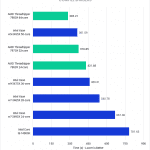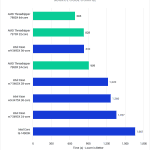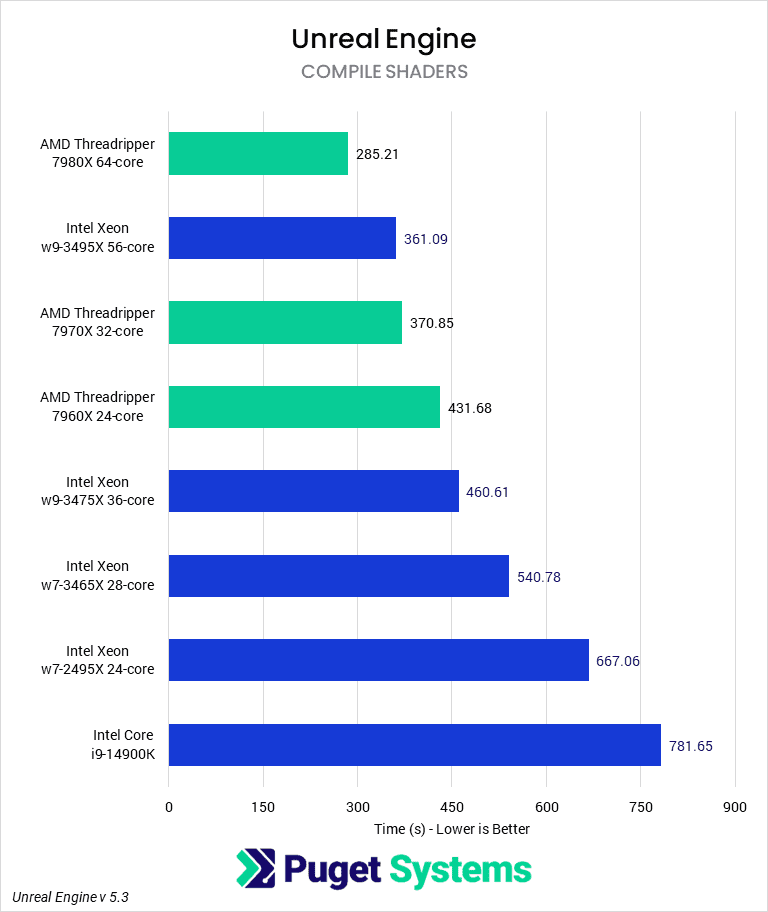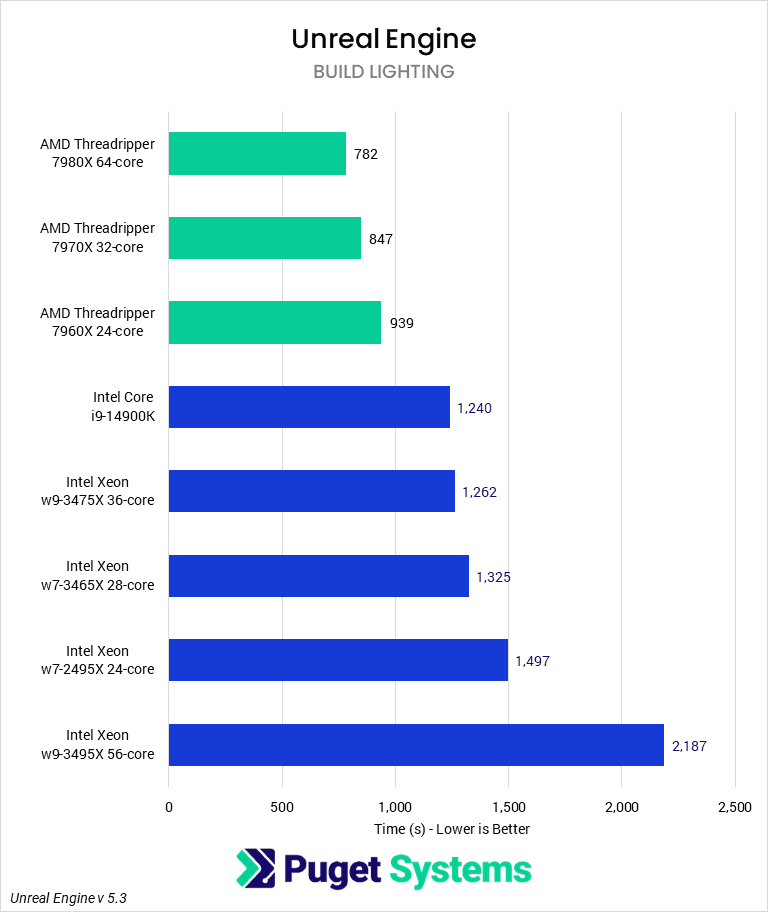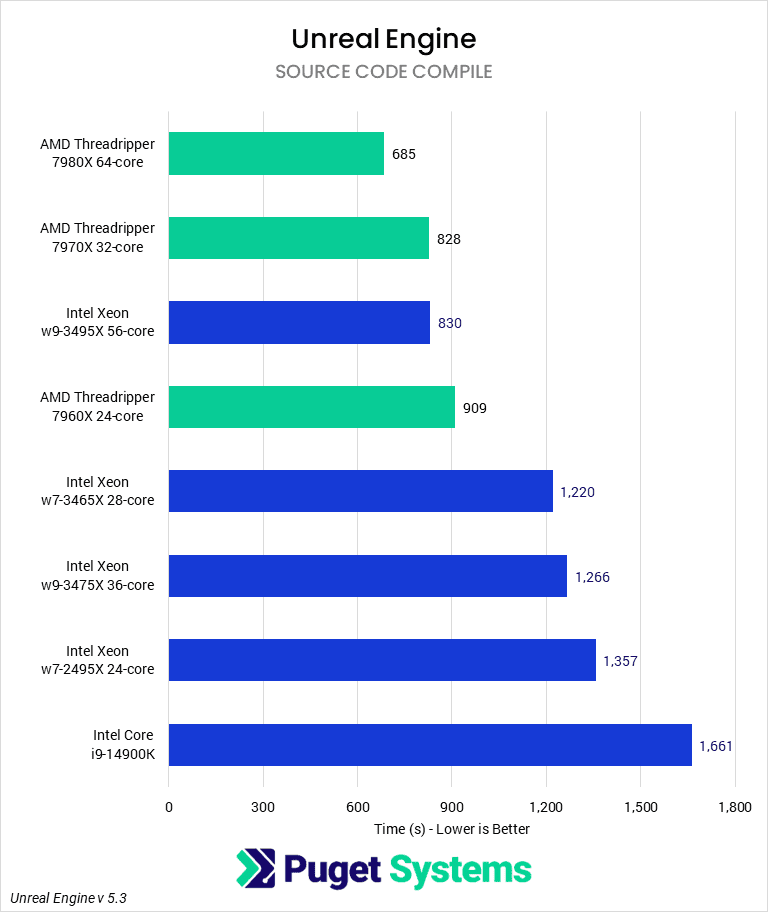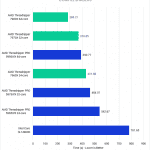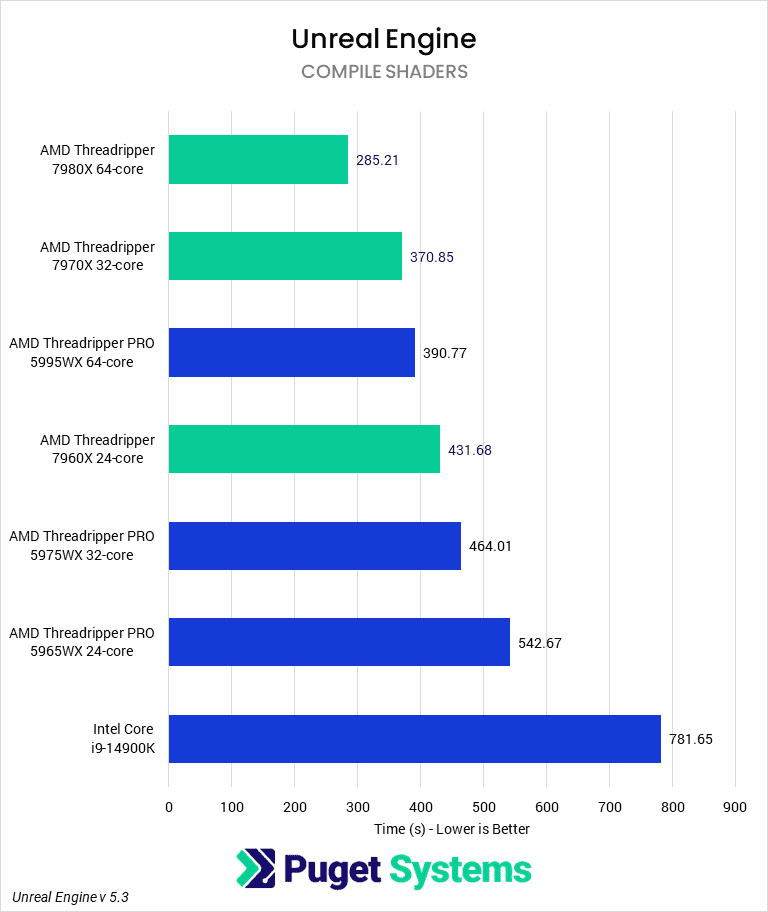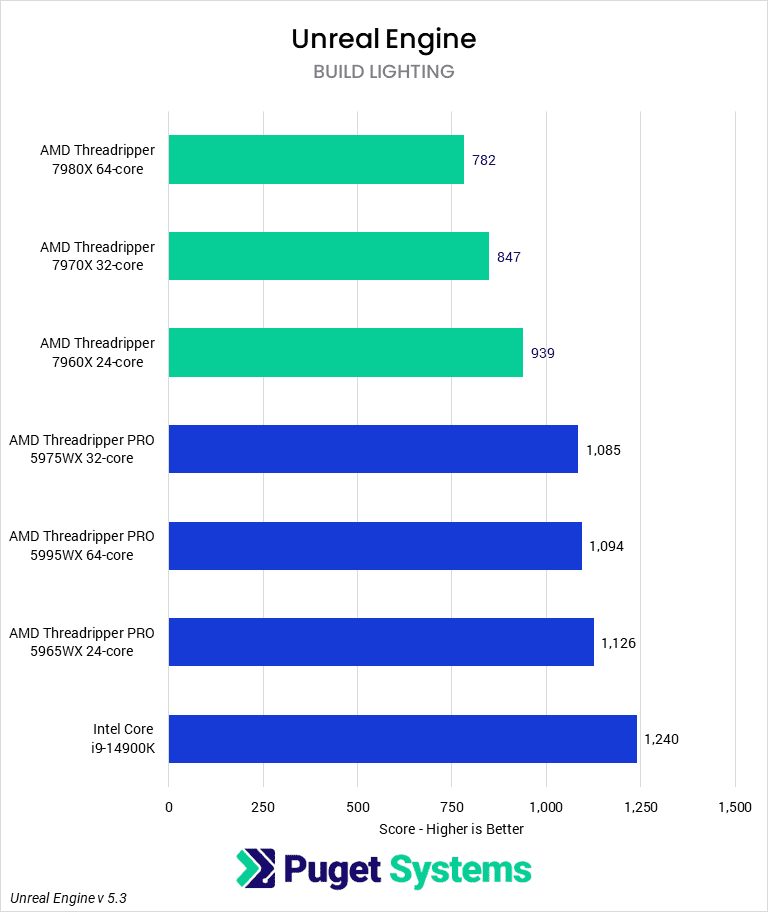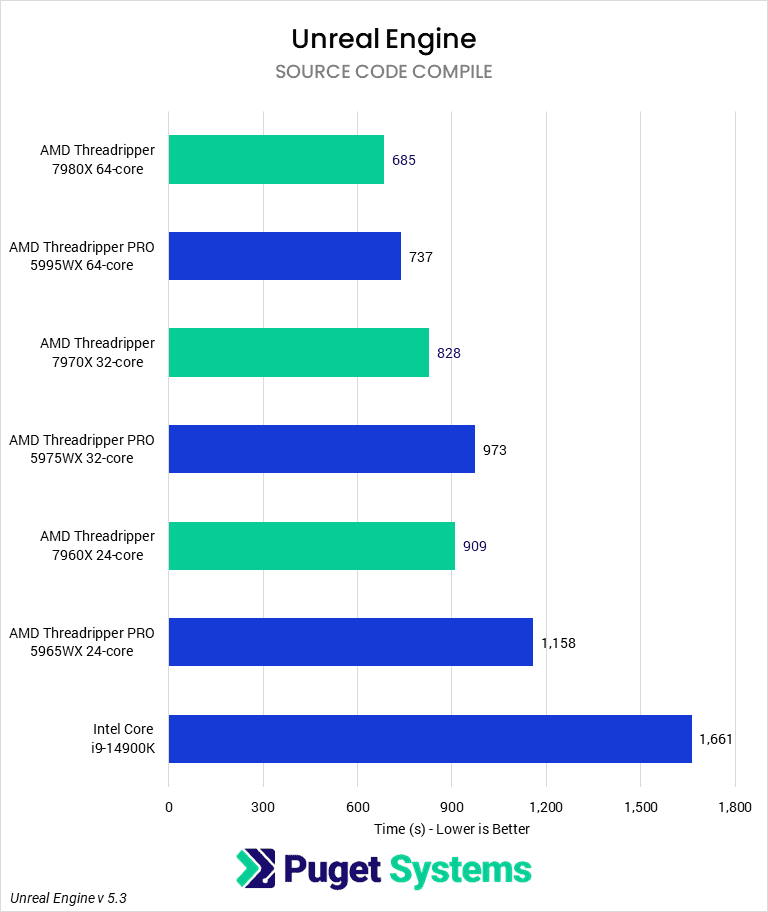Table of Contents
EDIT 1/26/24: The 64-core Threadripper 7980X performed lower than expected in our initial testing. After a few BIOS and Windows updates, and moving to newer motherboards, it is now performing as expected. Test results have been updated below.
TL;DR: AMD Threadripper 7000 Performance in Unreal Engine
The 64-core AMD Threadripper 7980X has an impressive 27% improvement in shader compile times, and 30% in baked lighting. The 32-core 7970X was a consistent winner in Unreal Engine. Averaging 20-25% faster than the previous generation, and outperforming every Intel Xeon tested, while costing much less. It makes for a solid choice for anyone looking for the best performance for Unreal Engine development.
Introduction
On October 19, AMD announced their AMD Ryzen Threadripper 7000 Series and AMD Ryzen Threadripper PRO 7000 WX-Series processors. The former is an exciting re-entry for AMD into the High-End Desktop (HEDT) market. At the same time, the latter represents their latest workstation offering, building on the existing Threadripper PRO 5000 WX-Series. Both CPU families are based on AMD’s Zen 4 architecture, which is currently powering their Ryzen 7000 line of desktop processors and Genoa, Genoa X, and Bergamo EPYC processors. This upgrade in architecture means they now support new technologies like PCI-e Gen 5.0 and DDR5 memory.
Even though it has been over a month since AMD announced these processors, the workstation-focused WRX90 motherboards are still in extremely short supply. As such, at the moment, we are only benchmarking the Threadripper 7000 Series HEDT processors within the TRX50 platform. Expect to see a separate review of the Threadripper PRO 7000 WX-Series processors shortly.
In this article, we will examine the performance of the HEDT processors in Unreal Engine. In our Intel Xeon W-3400 review, we found that the Threadripper PRO 5000 Series CPUs traded performance wins with the Xeon chips, so we expect that the new Threadrippers will likely surpass Intel in all our Unreal tests. However, Unreal Engine has a lot of different uses, and much of it is typically GPU-bound. Because there are so many CPUs to examine, we will break our analysis down into Intel vs AMD (AMD Threadripper 7000 vs Intel Xeon W-3400) and performance versus the previous generation (AMD Threadripper 7000 vs AMD Threadripper PRO 5000).
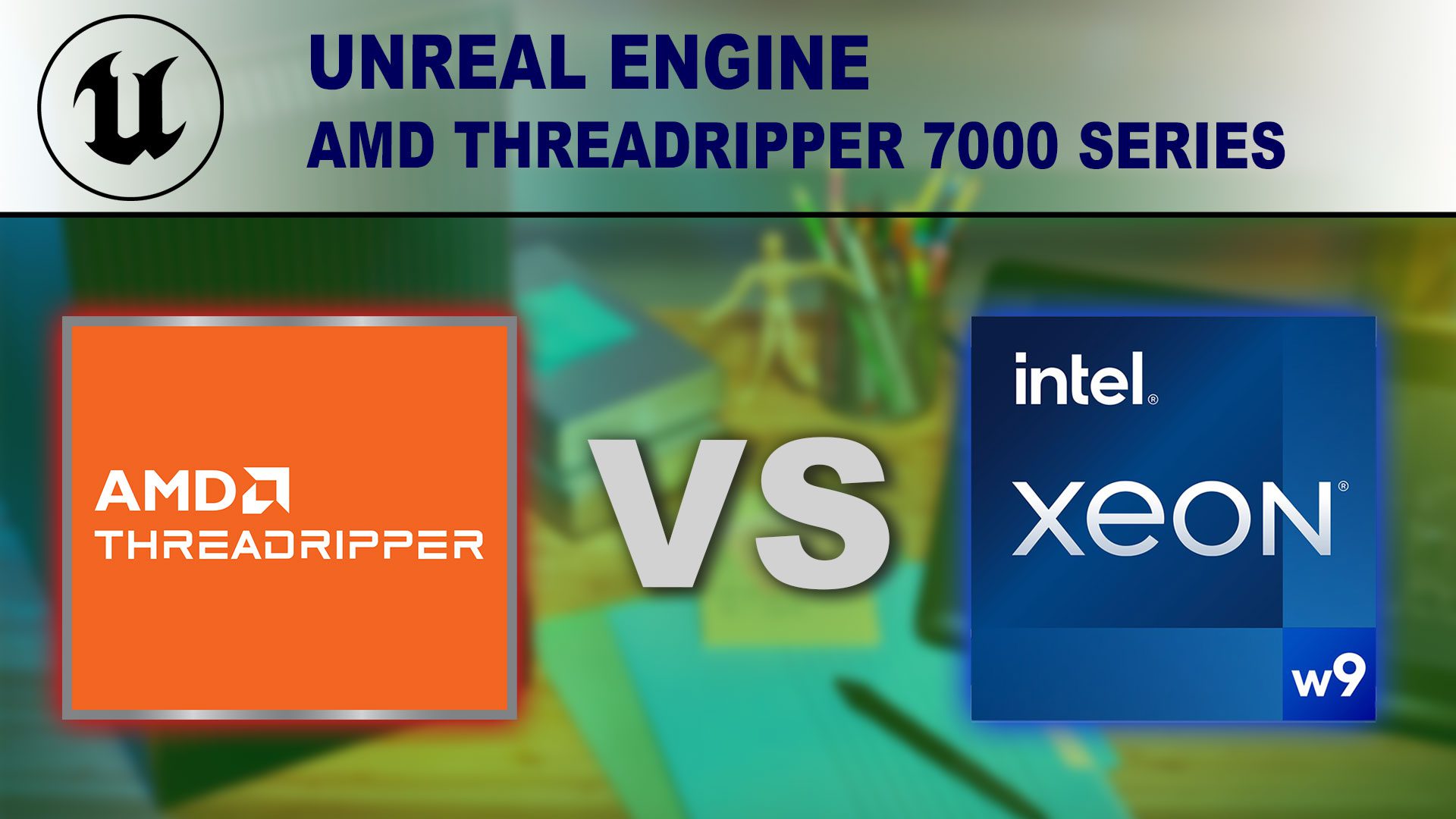
To learn more about how the new AMD Ryzen Threadripper 7000 Series processors perform in other workflows, we have compiled an overview in our AMD Ryzen Threadripper 7000 Content Creation Review article. That post also includes more detailed information on the CPU specifications and test results for various applications: Lightroom Classic, Photoshop, Premiere Pro, DaVinci Resolve, After Effects, Cinema 4D, Blender, and V-Ray.
In addition, although all the new AMD CPUs have a TDP of 350 W, TDP is rarely the whole story. To see how much power these chips use to complete tasks, check out our Power Analysis: AMD Ryzen Threadripper 7000 article.
AMD Threadripper 7000 vs Intel Xeon W-3400 for Unreal Engine
Unreal Engine has a very wide variety of users in different industries, and most of the heavy lifting in Unreal Engine is GPU-bound. Regarding CPU-specific tasks, we look at shader compilation (which everyone experiences from time to time at the very least), light baking, and code compilation in Visual Studio. Light baking is quickly falling out of favor with the adoption of Lumen and GPU Lightmass, but some users may still prefer it.
Updated 1/26/24: Starting with the top of the new Threadripper CPUs, the 7980X, we initially saw some mixed results however after a few BIOS and Windows updates, it is working as expected. In the Shader compile test, we see this new CPU post a 20% lead over the Intel Xeon x9-3495X. We must also keep in mind that the Threadripper is also more expensive. Turning to Light baking and source code compiling, we see the 64-core continue its lead over the rest of the pack, though the 56-core Intel Xeon now experiences issues and falls to the bottom of the light baking chart.
The 32-core Threadripper 7970X was much more consistent in the tests. It either tied or beat the much more expensive 56-core Xeon w9-3495X in every test while blowing away the more comparably priced 36 and 28-core offerings from Intel.
Moving down to the 24-core Threadripper 7960X, it routinely outperformed the 24-core Xeon w7-2495 while also coming in a few hundred dollars less expensive. The best comparison to this CPU is the other Threadripper CPUs. How much time you spend on these tasks will determine how many cores you may want to go with as the cost escalates quickly.
AMD Threadripper 7000 vs AMD Threadripper PRO 5000 for Unreal Engine
In the previous section, we examined how the new Threadripper 7000 series CPUs stack up against Intel’s Xeon 3400 and 2400 series CPUs, but we should also examine how they compare to the previous 5000 series CPUs. As we can see from the charts, the new CPUs offer modest improvements over the previous generation.
Updated 1/26/24: In shader compiling, a task that every Unreal user has to sit through from time to time, we see a roughly 20-25% increase in compile times. This is after the updates that fixed the performance issues initially seen in the 64-core CPU. This 20-25% faster compile times is something that every user will welcome.
For light baking, we again see a roughly 20% improvement across the board. This test is a combination of multicore, instructions per clock, and disk read/write, so it tends to level off per architecture.
Lastly, for code compile, the new CPUs range from 10-20% faster. Again, a modest improvement. These results are not as impressive as we saw in the rendering benchmarks, but any improvement saves time.
How Well Do the AMD Threadripper 7000 CPUs Perform in Unreal Engine?
AMD’s new 7000-series Threadripper CPUs show a modest improvement over the previous generation, ranging from 26-35% faster. When compared to the Intel Xeon 3400 and 2400, launched a few months ago, there is no competition. At every price point, Threadripper has an advantage. While we had hoped for more from these CPUs, they are still the obvious choice for those who spend a lot of time compiling shaders or looking to configure a build server for their studio.
Every application uniquely utilizes hardware, so our results here don’t necessarily translate to any other application. Our focus in this article centers specifically on Threadripper 7000’s performance in Unreal Engine. However, we recommend checking out our AMD Ryzen Threadripper 7000 Content Creation Review article, which includes a broad overview of results for several different applications. If you use other software packages, it also has links to our in-depth testing articles for content creation: Lightroom Classic, Photoshop, Premiere Pro, DaVinci Resolve, After Effects, Cinema 4D, Blender, and V-Ray.
Finding the perfect workstation doesn’t have to be complicated. Explore our solutions page for a curated selection of recommended systems for a multitude of applications and workflows, or visit our custom configuration page if you already know the ideal hardware for your needs. If you need assistance with tailoring a system to a unique workflow or have any other questions, we encourage you to reach out to our dedicated technology consultants.


